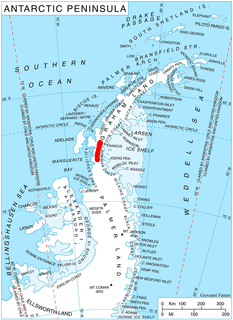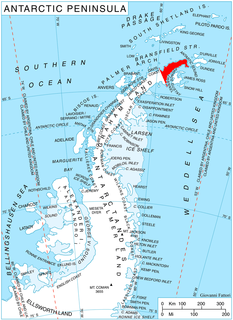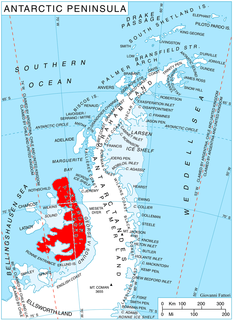
The Branscomb Glacier is an Antarctic glacier, 11 nautical miles long, flowing west from the north-west side of Vinson Massif into Nimitz Glacier, in the Sentinel Range of the Ellsworth Mountains. Its upper course receives ice influx from both Goodge Col and Jacobsen Valley, while the tributary Roché Glacier joins Branscomb Glacier just northwest of Príncipe de Asturias Peak.
The Lazarev Mountains are a chain of mountains in Antarctica. They extend along the west side of Matusevich Glacier southward of Eld Peak, and are about 25 nautical miles (50 km) long. The mountains were photographed from the air by U.S. Navy Operation Highjump (1946–47), the Soviet Antarctic Expedition (1957–58) and an Australian National Antarctic Research Expedition (1959). They were named by the Soviet expedition after Lieutenant Mikhail Petrovich Lazarev, commander of the sloop Mirnyy of the Bellingshausen expedition (1819–21).

Shambles Glacier is a steep glacier 4 miles long and 6 miles wide, with very prominent hummocks and crevasses, flowing east between Mount Bouvier and Mount Mangin into Stonehouse Bay on the east side of Adelaide Island. It is the island's largest glacier, and provides an eastern outlet from the giant Fuchs Ice Piedmont which covers the entire western two-thirds of the island. In doing so, Shambles Glacier provides the largest 'gap' in Adelaide Island's north-south running mountain chain.

The Airy Glacier is a glacier 20 nautical miles (37 km) long and 6 nautical miles (11 km) wide, flowing west to the northeast portion of Forster Ice Piedmont, near the west coast of the Antarctic Peninsula.

Finsterwalder Glacier is a glacier on the northwest side of Hemimont Plateau, 2 nautical miles wide and 10 nautical miles long, flowing southwest from the central plateau of Graham Land, Antarctica, toward the head of Lallemand Fjord. Its mouth lies between the mouths of Haefeli Glacier and Klebelsberg Glacier, the three glaciers merging with Sharp Glacier where the latter enters the fjord. It was first surveyed from the plateau in 1946–47 by the Falkland Islands Dependencies Survey, and named by them for Sebastian Finsterwalder and his son, Richard Finsterwalder, German glaciologists.

Aphrodite Glacier is a glacier 15 nautical miles (28 km) long flowing north to the east coast of the Antarctic Peninsula 3 nautical miles (6 km) west of Victory Nunatak.

Barnes Glacier is a glacier on the west side of Hemimont Plateau flowing west into Blind Bay on the west coast of Graham Land. It was named by the UK Antarctic Place-Names Committee in 1958 for Howard T. Barnes, Canadian physicist and pioneer of ice engineering.
Wells Glacier is a glacier 9 nautical miles west of Cape Brooks, flowing north into New Bedford Inlet in Palmer Land. Mapped by United States Geological Survey (USGS) from ground surveys and U.S. Navy air photos, 1961–67. Named by Advisory Committee on Antarctic Names (US-ACAN) for James T. Wells, storekeeper with the South Pole Station winter party in 1967.
Whirlwind Glaciers is a set of four prominent converging glaciers which flow into the west side of Whirlwind Inlet on the east coast of the Antarctic Peninsula. Discovered by Sir Hubert Wilkins on his flight of December 20, 1928, the glaciers were so named because their relative position was suggestive of the radial cylinders of his Wright Whirlwind engine. The Whirlwind Glaciers, comprising Flint, Demorest, Matthes, and Chamberlin Glaciers, were photographed from the air by the United States Antarctic Service (USAS) in 1940; charted by the Falkland Islands Dependencies Survey (FIDS) in 1948.

Whitecloud Glacier is a glacier which flows northward between Klokotnitsa Ridge on the east and Tsarevets Buttress on the west to discharge into Charcot Bay just west of Almond Point, Trinity Peninsula. Named by United Kingdom Antarctic Place-Names Committee (UK-APC) in 1960. The name is descriptive of cloud conditions that prevailed at the time of Falkland Islands Dependencies Survey (FIDS) survey of the area in 1948.

Coulter Glacier is a steeply inclined glacier, 5 nautical miles (9 km) long, flowing south from the Havre Mountains, northern Alexander Island, into Kolokita Cove in Lazarev Bay, Antarctica. The glacier was photographed from the air by the Ronne Antarctic Research Expedition in 1947 and mapped from the photographs by the Falkland Islands Dependencies Survey in 1960. It was named by the Advisory Committee on Antarctic Names for R.W. Coulter, Master of USNS Alatna during U.S. Navy Operation Deepfreeze, 1969.
Swinhoe Peak is a peak, 845 m, standing between Hamberg Glacier and Hestesletten on the north side of South Georgia. The peak was mapped by the Swedish Antarctic Expedition, 1901–04, under Nordenskjold. It was surveyed by the South Georgia Survey in the period 1951-57. Named by the United Kingdom Antarctic Place-Names Committee (UK-APC) for Ernest Swinhoe, Manager of the South Georgia Exploration Co., who visited South Georgia in 1905 to prospect for minerals and to consider the establishment of an experimental sheep ranch.
Mount Palsson is a large and conspicuous mountain rising to 1,190 m. The feature is located at the north end of Whirlwind Inlet between Flint Glacier and Demorest Glacier on the east coast of Graham Land. The mountain was photographed by the United States Antarctic Service (USAS), 1939-41. Named by United Kingdom Antarctic Place-Names Committee (UK-APC) for Sveinn Palsson (1762–1840), Icelandic naturalist who carried out pioneer work on glaciers and ice caps in Iceland.
Flint Glacier is a glacier which flows south into Whirlwind Inlet between Demorest Glacier and Cape Northrop, on the east coast of Graham Land, Antarctica. It was discovered by Sir Hubert Wilkins on his flight of December 20, 1928, and photographed from the air by the United States Antarctic Service in 1940. It was charted in 1947 by the Falkland Islands Dependencies Survey, who named it for glaciologist Richard F. Flint, professor of geology at Yale University.
Hariot Glacier is a glacier flowing northwest along the south side of Morgan Upland before turning west into the northern portion of the Wordie Ice Shelf, along the west coast of the Antarctic Peninsula. It was roughly surveyed by the British Graham Land Expedition, 1936–37, and the upper reaches were photographed from the air by the Ronne Antarctic Research Expedition, 1947. The glacier was surveyed from the ground by members of the Falkland Islands Dependencies Survey who travelled along it in December 1958, and it was named by the UK Antarctic Place-Names Committee after Thomas Hariot, an English mathematician who pioneered new methods of navigation under the patronage of Sir Walter Raleigh.

Hurley Glacier is a glacier between Mount Gaudry and Mount Liotard, flowing east into Ryder Bay, Adelaide Island, Antarctica. It was named by the UK Antarctic Place-Names Committee in 1977 after Alec J. Hurley, a British Antarctic Survey mechanic at Halley Station, 1975–76, and Rothera Station, 1976–77.
McArthur Glacier is a glacier between the Christie Peaks and Swine Hill, flowing west from Palmer Land, Antarctica, into George VI Sound. It was named by the UK Antarctic Place-Names Committee for Alistair H. McArthur, a British Antarctic Survey geophysicist at Stonington Island, 1967–68.
Secluded Rocks is a low, prominently banded rock outcrops between Mulebreen and Cosgrove Glacier, standing 6 nautical miles (11 km) south-southwest of Kemp Peak, Enderby Land. Mapped from ANARE surveys and air photos, 1954–66, and so named because the rocks are situated in a hollow.

Hough Glacier is a glacier in central Doyran Heights in the Sentinel Range of Ellsworth Mountains, Antarctica, rising just south of Mount Tuck and flowing east-southeast for 10 nautical miles between Guerrero Glacier and Remington Glacier. It was first mapped by the United States Geological Survey from surveys and U.S. Navy air photos, 1957–59, and was named by the Advisory Committee on Antarctic Names for William S. Hough, who made ionosphere studies at South Pole Station in 1957.


![]()








